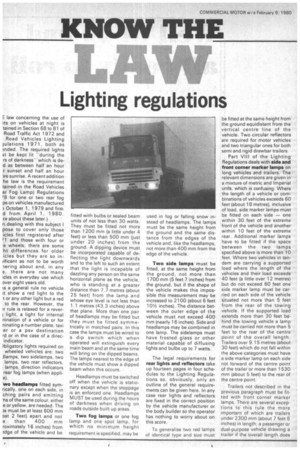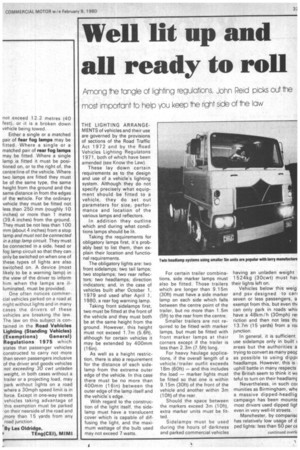Lighting regulations
Page 38

Page 39

If you've noticed an error in this article please click here to report it so we can fix it.
E law concerning the use of its on vehicles at night is tamed in Section 68 to 81 of Road Traffic Act 1 972 and Road Vehicles Lighting julations 1971, both as ?,nded. The required lights st be kept ht "during the rs of darkness'' which is ded as between half an hour r sunset and half an hour )re sunrise. A recent addition he law is the requirement tamed in the Road Vehicles ar Fog Lamp) Regulations 18 for one or two rear fog ps on vehicles manufactured October 1, 1979 and first d from April 1, 1980.
• re about these later.)
n dealing with this subject I pose to cover only those icles first registered after 7 1 and those with four or
• e wheels; there are some ht differences for older icles but they are so iniificant as not to be worth iering about and, in any e, there are not many icles in everyday use which over eight years old.
is a general rule no vehicle ;I show a red light to the t or any other light but a red to the rear. However, the rule is relaxed for a reverlight, a light for internal nination of a vehicle or for ninating a number plate, taxi or or a psv destination -d or in the case of a direcindicator.
)bligatory lights required on wheeled vehicles are: two Jlamps, two sidelamps, two lamps, two rear reflectors, lamps, direction indicators rear fog lamps (when applie).
'wo headlamps fitted symrically, one on each side, in ching pairs and emitting ris of the same colour, either e or yellow, are needed. The )s must be at least 600 mm ast 2 feet) apart and not than 400 mm roximately 16 inches) from ?.clge of the vehicle and be fitted with bulbs or sealed beam units of not less than 30 watts. They must be fitted not more than 1200 mm (a little under 4 feet) or less than 500 mm (just under 20 inches) from the ground. A dipping device must be incorporated capable of deflecting the light downwards and to the left to such an extent that the light is incapable of dazzling any person on the same horizontal plane as the vehicle, who is standing at a greater distance than 7.7 metres (about 25 feet) from the lamp and whose eye level is not less than 1.1 metres (43.3 inches) above that plane. More than one pair of headlamps may be fitted but they must be fitted symmetrically in matched pairs. In this case the lamps must be wired to a dip switch which when operated will extinguish every main beam and at the same time will bring on the dipped beams. The lamps nearest to the edge of the vehicle must show a dipped beam when this occurs.
Headlamps must be switched off when the vehicle is stationary except when the stoppage is an enforced one. Headlamps MUST be used during the hours of darkness when driving on roads outside built up areas.
Two fog lamps or one fog lamp and one spot lamp, for which no minimum height requirement is specified, may be used in fog or falling snow instead of headlamps. The lamps must be the same height from the ground and the same distance from the edges of the vehicle and, like the headlamps, not more than 400 mm from the edge of the vehicle.
Two side lamps must be fitted, at the same height from the ground, not more than 1700 mm (5 feet 7 inches) from the ground, but if the shape of the vehicle makes this impossible this measurement may be increased to 2100 (about 6 feet 101/2 inches). The distance between the outer edge of the vehicle must not exceed 400 mm (nearly 16 inches). Side and headlamps may be combined in one lamp. The sidelamps must have frosted glass or other material capabLe of diffusing lights and bulbs up to 7 watts.
The legal requirements for rear lights and reflectors take up fourteen pages in four schedules to the Lighting Regulations so, obviously, only an outline of the general requirements can be given here. In any case rear lights and reflectors are fixed in the correct position by the vehicle manufacturer or the body builder so the operator has nothing to worry about on this score.
To generalise two red lamps of identical type and size must be fitted at the same height from the ground equidistant from the vertical centre line of the vehicle. Two circular reflectors are required for motor vehicles and two triangular ones for both semi and rigid drawbar trailers.
Part VIII of the Lighting Regulations deals with side and front corner marker lamps on long vehicles and trailers. The relevant dimensions are given in a mixture of metric and Imperial units, which is confusing. Where the length of a vehicle or combinations of vehicles exceeds 60 feet (about 18 metres), inclusive • of load, side marker lamps must be fitted on each side — one within 30 feet of the extreme front of the vehicle and another within 10 feet of the extreme rear. Additional marker lamps have to be fitted if the space between the two lamps specified above is more than 10 feet. Where two vehicles in tandem are carrying a supported load where the length of the vehicles and their load exceeds 40 feet (a little over 12 metres) but do not exceed 60 feet one side marker lamp must be carried on each side of the vehicle situated not more than 5 feet from the rear of the towing vehicle. If the supported load extends more than 30 feet behind the towing vehicle a lamp must be carried not more than 5 feet to the rear of the centre point of the overall length. Trailers over 9.15 metres (about 30 feet) which do not fall within the above categories must have a side marker lamp on each side not forward of the centre point of the trailer or more than 1530 mm (about 5 feet) to the rear of the centre point.
Trailers not described in the previous paragraph must be fitted with front corner marker lamps. There are several exceptions to this rule the more important of which are trailers under 2300 mm (about 7 feet 6 inches) in length; a passenger or dual-purpose vehicle drawing a trailer if the overall length does
not exceed 12.2 metres (40 feet), or it is a broken down vehicle being towed.
Either a single or a matched pair of fear fog lamps may be fitted. Where a single or a matched pair of rear fog lamps may be fitted. Where a single lamp is fitted it must be positioned on, or to the right of, the centre line of the vehicle. Where two lamps are fitted they must be of the same type, the same height from the ground and the same distance in from the edges of the ,vehicle. For the ordinary vehicle they must be fitted not less than 250 mm (roughly 10 inches) or more than 1 metre (39.4 inches) from the ground. They must be not less than 100 mm (about 4 inches) from a stop lamp and must not be connected in a stop lamp circuit. They must be connected in a side, head or fog lamp circuit so that they can only be switched on when one of these types of lights are also switched on. A device (most likely to be a warning lamp) in the view of the driver to inform him when the lamps are illuminated, must be provided.
One often notices commercial vehicles parked on a road at night without lights and in many cases the drivers of these vehicles are breaking the law. The law on this subject is contained in the Road Vehicles Lighting (Standing Vehicles) (Exemptions) General) Regulations 1975 which states that passenger vehicles constructed to carry not more than seven passengers inclusive of the driver and goods vehicles not exceeding 30 cwt unladen weight, in both cases without a trailer or a projecting load, may park without lights on a road where a 30mph speed limit is in force. Except in one-way streets vehicles taking advantage of this exemption must be parked on their nearside of the road and more than 15 yards from any road junction.
By Les Oldridge,




















































































































